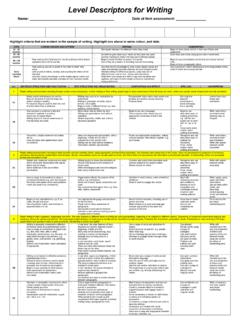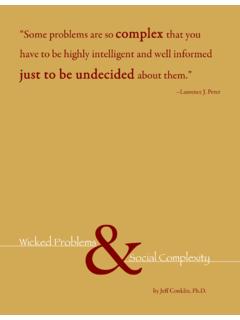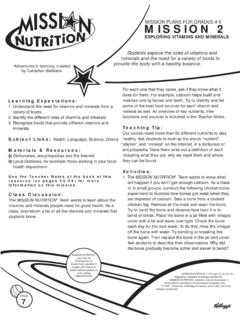Transcription of SCRIPT WRITING FOR SHORT FILMS: A Practical Guide In 8 …
1 SCRIPT WRITING FOR SHORT FILMS: A Practical Guide In 8 Steps Stuart Hepburn Lecturer in Screenwriting and Performance University of the West of Scotland This Screenwriting Guide has been written as a Practical Step By Step account of how you can go from being an unproduced filmmaker to a winner, in a few basic steps. We want you to able to write the best five minute screenplay possible. We want you to play with the form, experiment, and most importantly, find your own voice. Introduction: FilmG The Gaelic Shorts Competition The FilmG Shorts competition is a fantastic opportunity for anyone wishing to take their first steps in making a SHORT film . However, to succeed in the competition, you have to ensure that your film is as good as it possibly can be. Why? Because five minutes is a SHORT time, and any deficiencies in the SCRIPT will be exposed sooner rather than later.
2 You only have one chance with your SCRIPT , and if you miss it, you have lost your audience. These are NOT a set of rules, but simply a suggested strategy for WRITING your film . THE 8 STEPS 1. Find a small idea 2. Explore the structure 3. Define your world, character and problem 4. Beat it out 5. Write the first draft 6. Find a critical friend 7. Write the second draft 8. Write the third draft STEP 1: Find a small idea It may be stating the obvious, but every SHORT film needs, at its core, an idea. This idea can be as simple as a sentence, an image, a metaphor, or even a line of poetry. Whatever form it takes, it must be small and able to be explored in emotional depth, in five minutes. Think of your film as the visual expression of this small idea. Here are some of the small ideas behind recent successful FilmG shorts.
3 A young girl comes to terms with her grandfather s death. A superhero is revealed as a deluded loser. A hospital patient learns an important lesson for life. What unites these films is that they are all SHORT , simple ideas. Again and again, the most common mistake which new filmmakers make is that their idea is TOO BIG! If it takes longer than one sentence to describe your film , it is TOO BIG. You will end up hurriedly skimming over a complicated story, and not exploring a simple one in depth. a small idea which moves you, and which can be described in one sentence. STUART S FILMG TOP TIP 1: SHORT films are very GOOD for exploring single, clear events in the life of one character, they are very BAD at exploring multiple complex events in the lives of many characters.
4 STEP 2: Explore the structure in your idea. You might think of a SHORT film as having: i A beginning ii A middle iii An end So far so good, but structure is not quite as simple as just discovering these three parts. Structure is not just a thing to discover, it is a relationship. It is the relationship of the parts of your film , to the whole. It s how the beginning relates to the end, the middle to the beginning, and the middle to the end. We call this deep structure, and every single emotionally satisfying film has it. STUART S FILMG TOP TIP 2: Write your idea on a piece of paper and stick it above your monitor. Write Don t be boring on a piece of paper, and stick it below your monitor. STEP 3: Define your character, their problem, and their world Successful SHORT films usually consist of a Character, with a Problem, in a World we understand, looking for a Solution.
5 These elements - a character, in a world, with a problem, are the three basic building blocks to use to develop your deep structure, and hence find an emotionally satisfying solution. Discover these, and how they interplay with one another, and you will discover your deep structure. Ask yourself these questions - Who is my character? Where are they experiencing their problem? What is the solution? STUART S FILMG TOP TIP 3: Don t write a single word of dialogue before you have worked out what your structural relationship actually is! STEP 4: Beating it out. Beating is an old Hollywood term, used to describe the process of working out the storyline, and that s what you have to do now. Let s say that you have decided that your character is a blind juggler, that her world is Christmas on Islay, and that her problem is that she is lonely.
6 I mentioned Christmas here, and it is no coincidence. SHORT films are excellent for investigating specific times of the year, specific rituals and specific human activity. I said Christmas on Islay but it could just as easily be - A Disco in Dundee A Funeral in Fort William Nuptials in New York Either way, choose a world which you know and understand, a character with whom you can identify, and a problem which moves you. You then have the tools to start the next process of Beating it out . Your SHORT five minute film will probably have about 8-12 major beats or scenes, and it s your task now to work out what they are. You could beat out a five minute film in five minutes using this convention: Beat 1. Introduce the world of Christmas on Islay Beat 2. Introduce the character of the Blind Juggler Beat 3.
7 Introduce the problem of the Blind Juggler - she is lonely Beat 4. The character chooses to solve the problem - she invents an imaginary friend Beat 5. The character experiences a major set back - playing with her friend, she falls and loses her juggling balls in the sea Beat 6. The character is almost defeated - she is depressed and closes down to life, ignoring Christmas Beat 7. The character rejects a solution - Santa is at the door on Christmas eve with a present but she sends him away Beat 8. The character discovers the solution, but in a surprising way - Santa leaves her a present of brand new juggling balls, and then turns out to be the handsome stranger who has moved in next door OK, so it s not Gone With The Wind, but it only took me five minutes! Take your idea and do the same, but take a bit longer.
8 STUART S FILMG TOP TIP 4: Show, don t tell. This is the stage where you should be thinking of imagery and visuals. One picture paints a thousand words, and there should be a strong image in each beat. STEP 5: Write The First Draft. WRITING for film is about telling stories in pictures, in the most economical way possible. Think of the words of dialogue as being like ten pound notes. Don t spend a single penny more than you have to, tell the story in the least number of words you possibly can. Download a free copy of Celtx SCRIPT WRITING software from and using your beats as the basis for each of the scenes, your SCRIPT will flow off the page correctly formatted. Nothing will make your SCRIPT less likely to be successful than if it is not properly formatted. From Bejing to Reykjavic, all scripts are formatted in the same way, so make sure you use Celtx, or Final Draft if you can afford it, to type your SCRIPT out correctly.
9 Your SCRIPT will probably have expanded to about 12 scenes by now, and be approximately 5 to 7 pages long. If it s more than 8 pages, it s too long, less than 4 pages, and it s probably too SHORT . That s why we format in the same way, so that we can time the film . Time is money, and you don t want to waste a thing. STUART S FILMG TOP TIP 5: Don t judge yourself, don t be afraid to be less than perfect. WRITING is really re- WRITING , so write your first draft as fast as you can, and don t read it back till you are finished. STEP 6: Find a critical friend. Your critical friend is someone you know, or can contact, who understands scripts. This is NOT your mother, fianc , best friend or anyone else who likes you but doesn t know how to read a SCRIPT . They will tell you they loved it and say you are very clever, or that they hated it and you should take up knitting.
10 Either way it will get you precisely nowhere. Your critical friend, on the other hand, will read your SCRIPT and give you an honest appraisal. Listen to their feedback, and then do a considered rewrite, taking your time, based on their comments. Try to make this draft the one which clarifies everything, which focuses in on the problem, which irons out logical inconsistencies. Be prepared to throw away your favourite scenes. If it doesn t advance the story, get rid of it. STUART S FILMG TOP TIP 6: Do not be defensive. Listen to what your critical friend says and take heed. STEP 7: The second draft. Your screenplay is now in its second draft, and when you read it again you will probably hate it. It s too it s lost its it s not what you wanted to it s too wordy, and so on.








